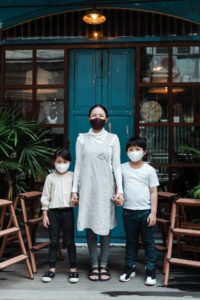 Much has been said about the need for the government to listen to experts and professionals by re-thinking its Covid-19 containment strategy in view of the growing number of cases as reported on a daily basis that doesn’t seem to be letting up.
Much has been said about the need for the government to listen to experts and professionals by re-thinking its Covid-19 containment strategy in view of the growing number of cases as reported on a daily basis that doesn’t seem to be letting up.
Effective containment strategy proposed by the experts entails the government focussing its resources towards FTTI (F=Finding, T=Tracing, T=Testing, I=Isolation). This in turn has to be based primarily on the ‘k’-dispersion factor. The ‘k’ has to do with concentration of the distribution of transmission. The rate of transmission in turn is measured by the R0, i.e., the average or typical reproduction rate. So that, if it’s 1.5, this means that on average an infected individual has the capability to infect or generally infects 1 to 2 other individuals.
As pointed out in an EMIR Research article, “Consider the ‘k’: Total Nationwide Lockdowns May Not Be the Only Way” by Margarita Peredaryenko & Ameen Kamal (The Star, Jan’ 21, 2021), the R0 on its own may not be exactly reflective of the actual situation on the ground. That is, the rate and distribution of the transmission isn’t evenly spread out in practice. To quote the article, “By now it is already a well-established empirical fact that Covid-19, like other representatives of the coronavirus family, in terms of the R appears to follow negative binomial distribution which means that the virus tends to spread in a population unevenly or in bursts”.
This is why the ‘k’-dispersion factor is to be combined with the positivity percentage, again as suggested by the experts and professionals. What the positivity percentage simply means is the percentage of those who are identified as infected out of those tested.
The World Health Organisation (WHO)’s recommendation is 5% and below whereas our testing positive rate registered 8.9% as of Jan 3, 2021. A rate higher than 5% would suggest or imply an R0 that’s speeding up which is precisely what we’re seeing – with the four-digit number of infections on a daily basis.
As of Jan 10, 2021, more than nine out of 10 active Covid-19 clusters in Malaysia had a test positivity rate of above 5%. This translates from 236 clusters out of a total of 254 clusters that have been tested as of that date which makes an astounding 93% high. There are, as of Jan 25, 2021, 351 clusters nationwide.
As it is, the R0 in general and the number of daily cases whilst indicative of the severity of the situation shouldn’t be decisive in terms of the method of containment, i.e., whether MCO should be deployed.
In other words, the rate of transmission of the epidemic is dependent upon other factors such as housing conditions, location, quarantine compliance, etc. – which contribute to super-spreading events (SSE).
As the Lancet journal puts it in “Offline: COVID-19 is not a pandemic” (Vol. 396, Issue 10255, Sep 26, 2020), the pandemic or epidemic should also be understood as “syndemic”, i.e., the interaction between Covid-19 and array of non-communicable diseases (NCD) that are worsened by pre-existing health, socio-economic and social conditions.
As urged in the article, “Use Science And Best Practices to Battle Covid-19” by Dr Dzulkefly Ahmad (Member of Parliament (MP) for Kuala Selangor, former Minister of Health); Dr Lee Boon Chye (MP for Gopeng, former Deputy Minister of Health); Yeo Bee Yin (MP for Bakri, former Minister of Energy, Science, Technology, Environment and Climate Change); and Isnaraissah Munirah Majilis (MP for Kota Belud, former Deputy Minister of Energy, Science, Technology, Environment and Climate Change), the government definitely needs to ramp up testing in the high-risk clusters for the construction and manufacturing sectors – housing and workplaces (construction sites, factories) – as well as prisons and the surrounding communities.
 To save time and costs, the government could do “pool/batch testing” – which means specimens from multiple persons are combined and tested via a single test, either on a more accurate yet costly and relatively time-consuming RT-PCR (reverse transcription polymerase chain reaction) or through a cheaper and faster RTK-Ag (Rapid Test-Kit Antigen). So, for example, nasal swabs taken via a screening facility can then be combined according to batches. According to the American Society of Microbiology, pool testing can substantially improve the efficiency of public health screening and population-level surveillance of diseases. MP for Klang Charles Santiago has called on the government to conduct pool testing for quicker turnaround time and more effective deployment of resources (“Time to rethink our Covid-19 housing strategy on migrant workers”, Malaysiakini, Jan 27, 2021).
To save time and costs, the government could do “pool/batch testing” – which means specimens from multiple persons are combined and tested via a single test, either on a more accurate yet costly and relatively time-consuming RT-PCR (reverse transcription polymerase chain reaction) or through a cheaper and faster RTK-Ag (Rapid Test-Kit Antigen). So, for example, nasal swabs taken via a screening facility can then be combined according to batches. According to the American Society of Microbiology, pool testing can substantially improve the efficiency of public health screening and population-level surveillance of diseases. MP for Klang Charles Santiago has called on the government to conduct pool testing for quicker turnaround time and more effective deployment of resources (“Time to rethink our Covid-19 housing strategy on migrant workers”, Malaysiakini, Jan 27, 2021).
And to reiterate, the policy proposals in “An open letter to Prime Minister Muhyiddin Yassin” (Malaysiakini, Jan 7, 2021) as well others (such as the employment of 10000 contract tracers from among the youth and unemployed graduates as made by Dr Lee Boon Chye) should be wholly implemented by the government as part of the exit-strategy. Dr Musa Nordin has recommended that the RT-PCR test is better suited for analytical sensitivity and clinical diagnosis within hospitals and deploying the RTK-Ag for screening purposes instead (“Covid-19 management: If it ain’t broke, don’t fix it”, Malaysiakini, Jan’ 24, 2021).
When it comes to screening purposes to determine the triage of patient condition, the South Korean experience in hospital stratification to deal with Covid-19 is helpful in this regard (“Repurposing and reshaping of hospitals during the COVID-19 outbreak in South Korea”, One Health, Dec 10, 2020 as published on the website of the National Center for Biotechnology Information/NCBI). Unused buildings could be converted into additional dedicated Covid-19 Assessment Centres (CACs) with community screening facilities. At the same time, these CACs could also play the role of a primary care hospital and emergency transits.
Furthermore, as highlighted in an EMIR Research article, “Turn budget hotels into quarantine centres” by Farhan Kamaruddin (Daily Express, Jan 31, 2021), there’s a critical need to make use of available buildings as quarantine centres. Emmy Suraya Hussein, President of the Malaysian Budget Hotel Association, has stated that the government should seriously consider converting 2,300 budget hotels into low-risk quarantine and treatment centres to allow more efficient surveillance of Covid-19 patients. This move would also ease the cash flow issues of the hotel operators and maintain as well as even promote employment opportunities for tour guides who have been so badly affected – by being retrained for the purpose of ensuring the SOPs are observed in these quarantine centres.
Last but not least, even if an MCO has to be imposed, then it should be localised and area-specific in precise geographical terms based on the Ministry of Health’s epidemiological modelling – moving beyond the SEIR (susceptible, exposed, infectious, and recovered) computational model and incorporating artificial intelligence (AI) technologies such as the Artificial Intelligence in Medical Epidemiology (AIME) – as developed by Dr Dhesi Baha Rajah and Dr Helmi Zakariah – to also predict and forecast emergence of hotspots. AIME had successfully tracked dengue outbreaks in Penang before.
While the government should be safe in terms of the Proclamation of Emergency and enactment of the Emergency (Essential Powers) Ordinance 2021, their legitimacy could be challenged (during or aftermath) should containment efforts proved longer than expected. In adopting a more inclusive “whole of government, whole of society” approach by fully taking on board the recommendations of the experts and professionals, the (legitimacy of the) Proclamation and Ordinance could be further bolstered and any other legal challenges “pre-empted” in the future.
Jason Loh Seong Wei is Head of Social, Law & Human Rights at EMIR Research, an independent think tank focused on strategic policy recommendations based on rigorous research. (This article was submitted prior to the current MCO).
This article is the personal opinion of the writer and does not necessarily represent the views of The Malaysian Medical Gazette.
